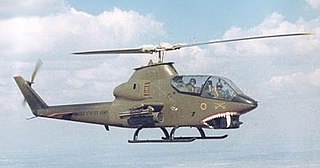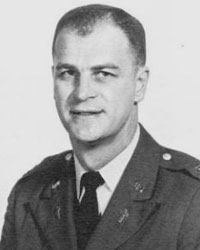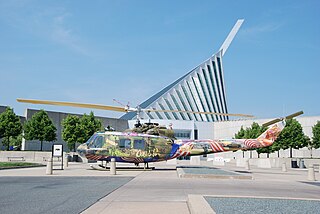
The Bell AH-1 Cobra is a single-engined attack helicopter developed and manufactured by the American rotorcraft manufacturer Bell Helicopter. A member of the prolific Huey family, the AH-1 is also referred to as the HueyCobra or Snake.

The Bell UH-1 Iroquois is a utility military helicopter designed and produced by the American aerospace company Bell Helicopter. It is the first member of the prolific Huey family, as well as the first turbine-powered helicopter in service with the United States military.

Casualty evacuation, also known as CASEVAC or by the callsign Dustoff or colloquially Dust Off, is a military term for the emergency patient evacuation of casualties from a combat zone. Casevac can be done by both ground and air. "DUSTOFF" is the callsign specific to U.S. Army Air Ambulance units. CASEVACs by air today are almost exclusively done by helicopter, a practice begun on a small scale toward the end of World War II; before that, STOL aircraft, such as the Fieseler Fi 156 or Piper J-3 were used.

Operation Frequent Wind was the final phase in the evacuation of American civilians and "at-risk" Vietnamese from Saigon, South Vietnam, before the takeover of the city by the North Vietnamese People's Army of Vietnam (PAVN) in the Fall of Saigon. It was carried out on 29–30 April 1975, during the last days of the Vietnam War. More than 7,000 people were evacuated by helicopter from various points in Saigon. The airlift resulted in a number of enduring images.

Charles James "Charlie" Liteky, formerly known as Angelo Liteky, was an American peace activist who served as a United States Army chaplain in the Vietnam War and was awarded the U.S. military's highest decoration, the Medal of Honor. A Roman Catholic priest, Liteky received the award for braving intense fire to carry 20 wounded soldiers to safety during a 1967 battle. He later left the priesthood, became a social activist, and in 1986 renounced his Medal of Honor.

A door gunner is a crewman tasked with firing and maintaining manually directed armament aboard a military helicopter. The actual role will vary depending on the task given on a particular mission. For certain aircraft a door gunner would use a fully automatic Gatling gun placement. On many larger aircraft such as military planes a turret is used along with heavy cannons.

Stephen Wesley Pless was a major in the United States Marine Corps during the Vietnam War. He earned the Medal of Honor as a UH-1 Iroquois "Huey" helicopter pilot for rescuing soldiers trapped by heavy enemy fire.

Operation Sure Win 202 was a 1964 Army of the Republic of Vietnam (ARVN) operation carried out with US support. ARVN commandos were transported by U.S. helicopters behind entrenched Viet Cong (VC) positions, attacking them with shoulder fired rockets and flame throwers. Sniper teams then tracked the fleeing rebels and engaged them.

Patrick Henry Brady, is a retired United States Army major general. While serving as a helicopter pilot in the Vietnam War, he received the Medal of Honor, the nation's highest military decoration for valor.

Major Charles Livingston Kelly was a United States Army helicopter pilot and medical evacuation unit commander during the Vietnam War. Because of the central role he played in the development of early battlefield evacuation techniques during the war—and the central role his death on the battlefield played in cementing those techniques in Army doctrine at a time they were being questioned by line commanders—he earned the sobriquet "The Father of Dustoff".

Bruce Perry Crandall is a retired United States Army officer who received the Medal of Honor for his actions as a pilot during the Battle of Ia Drang on November 14, 1965, in South Vietnam. During the battle, he flew 22 missions in a Bell Huey helicopter into enemy fire to evacuate more than 70 wounded and bring ammunition and supplies to United States forces. By the end of the Vietnam War, he had flown more than 900 combat missions. He retired from the army as a lieutenant colonel and worked several jobs in different states before settling down with his wife in his home state of Washington.

Ed W. "Too Tall" Freeman was a United States Army helicopter pilot who received the United States military's highest decoration, the Medal of Honor, for his actions in the Battle of Ia Drang during the Vietnam War. During the battle, he flew through gunfire numerous times, bringing supplies to a trapped American battalion and flying dozens of wounded soldiers to safety. Freeman was a wingman for Major Bruce Crandall who also received the Medal of Honor for the same missions.

The Bell UH-1N Twin Huey is a medium military helicopter designed and produced by the American aerospace manufacturer Bell Helicopter. It is a member of the extensive Huey family, the initial version was the CUH-1N Twin Huey, which was first ordered by the Canadian Forces in 1968.

Frederick Edgar Ferguson is a former United States Army warrant officer and later officer, as well as a recipient of the United States military's highest decoration—the Medal of Honor—for his actions in the Vietnam War while a chief warrant officer 3.

The Bell UH-1 Iroquois military helicopter, first introduced in 1959, is the first production member of the prolific Huey family of helicopters, and was itself developed in over twenty variants, which are listed below.
A Touch of Home: The Vietnam War's Red Cross Girls is an American documentary film produced and directed by Patrick and Cheryl Fries. The film tells the story of 627 young American women who served in the American Red Cross Supplemental Recreation Overseas Program during the Vietnam War. It was screened in Dallas, Texas on April 21, 2007.

Charles Seymour Kettles was a United States Army lieutenant colonel and a Medal of Honor recipient.

Take Me Home Huey is an art project and sculpture that was manifested from a discarded U.S. Army Bell UH-1 Iroquois helicopter, that served as an air ambulance for the U.S. Army in the Vietnam War. The serial number is 67-17174, commonly known as #174. Artist Steve Maloney created the concept and artwork using the restored helicopter's 47-foot long fuselage as a canvas. The composition includes a mule pack of soldier's duffels, public address speakers and a vinyl wrap of Vietnam Helicopter Squadron names, along with symbolic 1960's and 70's pop culture imagery of icons that many soldiers longed for. The cockpit contains a time capsule of original veteran's artifacts, along with the abstract suspension of miscellaneous helicopter parts and instruments that were part of the original aircraft.

Operation Shufly was a United States Marine Corps operation to improve the mobility of Army of the Republic of Vietnam (ARVN) forces in the early phases of the Vietnam War from 1962 to 1965. Beginning on 15 April 1962, Marine helicopter squadrons, associated maintenance units and air traffic control detachments deployed to Sóc Trăng Airfield in the Mekong Delta and later to Da Nang Air Base rotating every four months in order to provide assault support and CASEVAC assistance during combat operations. By early 1965 half of the Marine Corps' medium helicopter squadrons had rotated through a "Shufly" deployment. The operation ended on 8 March 1965, when the 9th Marine Expeditionary Brigade came ashore in Vietnam as the vanguard of the United States' commitment of large numbers of regular combat units into South Vietnam.

















